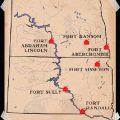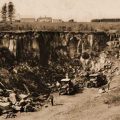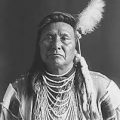
About 8,000 years ago (6,000 BCE), the American Indian cultures of the Northern Plains and the Columbia Plateau began undergoing a series of major changes. There was a decrease in dependence on big game hunting as the people engaged in a wide range of hunting and gathering patterns.
One of the events of regional importance was the eruption of Mount Mazama in Oregon in 4750 BCE. The volcano crater would later fill with water and become known as Crater Lake. The volcanic ash from this eruption covered much of the region, including parts of Montana. For today’s archaeologists, this ash layer provides a way of dating some archaeological sites.
Briefly described below are some of the Montana sites between 6000 BCE and 3000 BCE.
Sites:
Pretty Creek: By about 5735 BCE, Indian people were occupying the Pretty Creek (24CB4) site near the Bighorn River at the present-day Wyoming border. They were using basin-shaped fire pits into which they added stones to help hold the heat.
Hogback Homestead: In 5400 BCE, Indian people using Cascade points were now occupying the Hogback Homestead site (24GN13).
Black Bear Coulee: In 5000 BCE, Indian people were now occupying the Black Bear Coulee site which is located at an elevation of 4,000 feet just north of present-day Drummond.
In 4750 BCE, Indian people living at the Black Bear Coulee site witnessed ash falling over the hills and streams of western Montana from the eruption of Mount Mazama. Archaeologist Douglas MacDonald writes: “The layer of ash seems to have had little long-term effect on the people of western Montana: Early Archaic peoples lived there before and after the eruption with equal success.”
Middle Kootenai River: On a high terrace along the Middle Kootenai River valley near present-day Libby, Indian people were using site 24LN1054 by 5000 BCE. This was a winter residential base. The primary food resources included deer and elk. Archaeologist Douglas MacDonald, in his book Montana Before History: 11,000 Years of Hunter-Gatherers in the Rockies and Plains, writes: “Artifacts at the site include net weights used for trout fishing and pestles used to process root crops, which are abundant in the Kootenai valley.”
Graybeal: By 4890 BCE, Indian people were now using the Graybeal site (24GN61). This was a semi-permanent site used for wintering. The people at this site were using a type of point which the archaeologists call Salmon River Side-Notched.
Buckeye: In 4300 BCE, Indian people were occupying the Buckeye Site. Archaeologist Douglas MacDonald writes: “Plant remains at the Buckeye Site indicate use of prickly pear cactus and biscuitroot for food, and sagebrush and pine for firewood. The pine probably came from the nearby Pryor Mountains.”
Kobold: In 3700 BCE, Indian people were using a buffalo jump at the Kobold site (24BH406) along Rosebud Creek. The jump is a 25-foot-high sandstone escarpment. At a buffalo jump, Indian people would harvest bison by running the herd over the cliff and then butchering the carcasses in the area below the cliff.
Bear Paw Mountains: In 3500 BCE, Indian people were now using site 24HL1215 which is at an elevation of 4,680 feet in the Bear Paw Mountains. Archaeologist Douglas MacDonald writes: “The small occupation, perhaps a group of hunters, used the uplands of the Bear Paw Mountains for hunting and gathering.”
While they used local stone for making tools, they also had some exotic stone, including Knife River flint from western North Dakota and obsidian from present-day Yellowstone National Park in Wyoming.
Myers-Hindman: In 3500 BCE, Indian people were using the Myers-Hindman site (24PA504) near present-day Livingston for hunting bighorn sheep.
Pit House: In 3365 BCE, Indian people constructed a pit house in the south central portion of the state (site 24CB1332). They were exploiting many non-bison sources of food, including rabbit, deer, and pronghorn. They were also gathering a variety of plants.
Sun River: In 3200 BCE, Indian people occupied the Sun River site (24CA74) near present-day Great Falls during the fall. A group of about 25 people occupied the site for a few days. They were using a wide array of local fauna, including pronghorns.
Rigler Bluffs: By 3040 BCE, Indian people were using the Rigler Bluffs site (24PA401) on the southern bank of the Yellowstone River.
Complexes:
A complex is simply a group of tools and artifacts which are associated together at a number of different sites. Archaeologists use complexes for showing the relationships between different sites. A complex is also a chronological unit and thus can be used for the initial dating of a site.
Bristow Complex: In southeastern British Columbia and northwestern Montana, the period which archaeologists call the Bristow Complex began about 5500 BCE. This complex is characterized by the use of local glacial outwash and river gravels as the primary source for lithic raw materials. Bristow Complex projectile points are shallow or deep side to broad side/corner notched dart points.
Note: the information in parenthesis following the name of the site is the Smithsonian Designation System. In this system of recording archaeological sites, the first number refers to the state; this is followed by letters which refer to the county; and then a number indicating its order in being recorded. Thus 5LP 10, means that the site is in Colorado (5th state when the states are listed alphabetically), La Plata County (LP), and was the 10th site recorded in La Plata county in the State Archaeologist’s office.




Leave a Reply